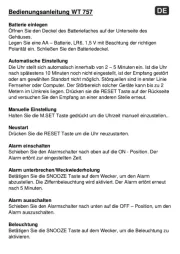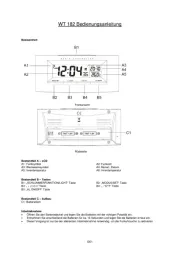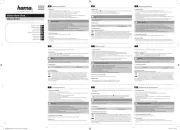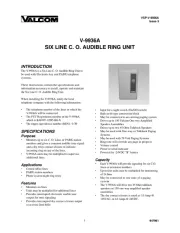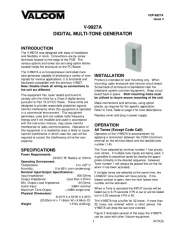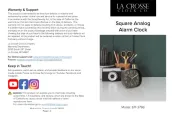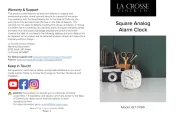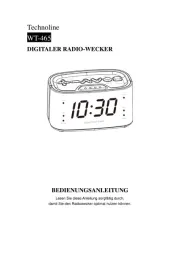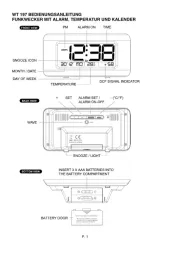Vielen Dank, dass Sie sich für dieses Gerät aus dem Hause TFA entschieden haben.
1. Bevor Sie mit dem Gerät arbeiten
•
Lesen Sie sich bitte die Bedienungsanleitung genau durch.
•
Durch die Beachtung der Bedienungsanleitung vermeiden Sie auch Beschädi-
gungen des Gerätes und die Gefährdung Ihrer gesetzlichen Mängelrechte
durch Fehlgebrauch.
•
Für Schäden, die aus Nichtbeachtung dieser Bedienungsanleitung verursacht
werden, übernehmen wir keine Haftung.
•
Beachten Sie besonders die Sicherheitshinweise!
•
Bewahren Sie diese Bedienungsanleitung gut auf!
2. Zu Ihrer Sicherheit
•
Verwenden Sie das Produkt nicht anders, als in dieser Anleitung dargestellt
wird.
•
Das eigenmächtige Reparieren, Umbauen oder Verändern des Gerätes ist nicht
gestattet.
Vorsicht!
Verletzungsgefahr:
•
Bewahren Sie das Gerät und die Batterie außerhalb der Reichweite von Kindern
auf.
•
Batterien nicht ins Feuer werfen, kurzschließen, auseinander nehmen oder auf-
laden. Explosionsgefahr!
•
Batterien enthalten gesundheitsschädliche Säuren. Um ein Auslaufen der Batte-
rien zu vermeiden, sollten schwache Batterien möglichst schnell ausgetauscht
werden. Beim Hantieren mit ausgelaufenen Batterien chemikalienbeständige
Schutzhandschuhe und Schutzbrille tragen!
Wichtige Hinweise zur Produktsicherheit!
•
Setzen Sie das Gerät keinen extremen Temperaturen, Vibrationen und Erschüt-
terungen aus.
•
Vor Feuchtigkeit schützen.
Empfang der Funkzeit DCF:
Die Zeitübertragung erfolgt von einer Cäsium Atom-Funkuhr, die von der Physika-
lisch Technischen Bundesanstalt in Braunschweig betrieben wird. Die Abweichung
beträgt weniger als 1 Sekunde in einer Million Jahren. Die Zeit ist kodiert und
wird von Mainflingen in der Nähe von Frankfurt am Main durch ein DCF-77
(77,5 kHz) Frequenzsignal übertragen mit einer Reichweite von ca. 1.500 km. Ihre
Funkuhr empfängt das Signal, wandelt es um und zeigt immer die exakte Zeit an.
Auch die Umstellung von Sommer- und Winterzeit erfolgt automatisch. Der Emp-
fang hängt hauptsächlich von der geographischen Lage ab. Im Normalfall sollten
innerhalb des Radius von 1.500 km ausgehend von Frankfurt bei der Übertragung
keine Probleme auftauchen.
Bitte beachten Sie folgende Hinweise:
•
Es wird empfohlen, einen Abstand von mindestens 1,5 – 2 Metern zu eventuell
störenden Geräten wie Computerbildschirmen und Fernsehgeräten einzuhalten.
•
In Stahlbetonbauten (Kellern, Aufbauten) ist das empfangene Signal natürli-
cherweise schwächer. In Extremfällen wird empfohlen, das Gerät in Fensternähe
zu platzieren, um das Funksignal besser zu empfangen.
•
Nachts sind die atmosphärischen Störungen meist geringer und ein Empfang ist
in den meisten Fällen möglich. Ein einziger Empfang pro Tag genügt, um die
Genauigkeit zu gewährleisten und Abweichungen unter 1 Sekunde zu halten.
3. Bedienung
•
Öffnen Sie das Batteriefach und legen Sie die Batterie (1 x 1,5 V AA) ein, +/- Pol
wie abgebildet. Das Gerät ist jetzt betriebsbereit.
• Die Uhr stellt sich auf 4, 8 oder 12 h und versucht nun, das Funksignal 10 min.
lang zu empfangen. Wenn der Zeitcode empfangen wurde, erscheint das DCF
Funksymbol im Sekundendisplay und die funkgesteuerte Zeit wird angezeigt.
Sollte kein Zeitcode empfangen worden sein, aktivieren Sie den Empfang
erneut durch Herausnehmen (1 min. lang) und wieder Einlegen der Batterie.
3.1 Alarm
•
Stellen Sie mit dem Einstellknopf auf der Rückseite die gewünschte Alarmzeit
ein.
• Schieben Sie den Alarm-Schalter nach oben auf „ON“. Die Alarm-Funktion ist
aktiviert.
• Wenn der Wecker klingelt, lösen Sie die Snooze-Funktion mit der „SNOOZE/
LIGHT“ Taste an der Oberseite aus. Der Alarmton wird dann für 5 Minuten
unterbrochen.
• Um die Alarm-Funktion zu deaktivieren, schieben Sie den Alarm-Schalter nach
unten auf „OFF“.
3.2 Beleuchtung
•
Mit der „SNOOZE/LIGHT“ Taste können Sie die Anzeige für 5 sec. beleuchten.
4. Pflege und Wartung
•
Reinigen Sie das Gerät mit einem weichen, leicht feuchten Tuch. Keine Scheuer-
oder Lösungsmittel verwenden!
•
Entfernen Sie die Batterie, wenn Sie das Gerät längere Zeit nicht verwenden.
•
Bewahren Sie Ihr Gerät an einem trockenen Platz auf.
5. Fehlerbeseitigung
Problem Lösung
Keine Zeigerbewegung ➜ Batterie polrichtig einlegen
➜ Batterie wechseln
Kein DCF Empfang Empfangsversuch in der Nacht abwarten➜
➜Anderen Aufstellort für das Gerät wählen
➜ Beseitigen der Störquellen
➜ Neuinbetriebnahme des Gerätes gemäß Anleitung
Unkorrekte Anzeige Batterie wechseln➜
Wenn Ihr Gerät trotz dieser Maßnahmen immer noch nicht funktioniert, wenden Sie
sich an den Händler, bei dem Sie das Produkt gekauft haben.
6. Entsorgung
Dieses Produkt wurde unter Verwendung hochwertiger Materialien und Bestand-
teile hergestellt, die recycelt und wiederverwendet werden können.
Batterien und Akkus dürfen keinesfalls in den Hausmüll!
Als Verbraucher sind Sie gesetzlich verpflichtet, gebrauchte Batterien
und Akkus zur umweltgerechten Entsorgung beim Handel oder ent-
sprechenden Sammelstellen gemäß nationaler oder lokaler Bestim-
mungen abzugeben.
Die Bezeichnungen für enthaltene Schwermetalle sind: Cd=Cadmium,
Hg=Quecksilber, Pb=Blei
Dieses Gerät ist entsprechend der EU-Richtlinie über die Entsorgung
von Elektro- und Elektronik-Altgeräten (WEEE) gekennzeichnet.
Dieses Produkt darf nicht mit dem Hausmüll entsorgt werden. Der
Nutzer ist verpflichtet, das Altgerät zur umweltgerechten Entsorgung
bei einer ausgewiesenen Annahmestelle für die Entsorgung von Elek-
tro- und Elektronikgeräten abzugeben.
7. Technische Daten
Spannungsversorgung: 1 x 1,5 V AA Batterie (inklusive)
Gehäusemaße: 125 x 60 x 118 mm
Gewicht: 164 g (nur das Gerät)
Diese Anleitung oder Auszüge daraus dürfen nur mit Zustimmung von TFA Dostmann veröffent-
licht werden. Die technischen Daten entsprechen dem Stand bei Drucklegung und können ohne
vorherige Benachrichtigung geändert werden.
Die neuesten technischen Daten und Informationen zu Ihrem Produkt finden Sie unter Eingabe
der Artikel-Nummer auf unserer Homepage.
EU-KONFORMITÄTSERKLÄRUNG
Hiermit erklärt TFA Dostmann, dass der Funkanlagentyp 98.1086 der Richtlinie 2014/53/EU ent-
spricht. Der vollständige Text der EU-Konformitätserklärung ist unter der folgenden Internet-
adresse verfügbar:
www.tfa-dostmann.de
E-Mail: info@tfa-dostmann.de
TFA Dostmann GmbH & Co.KG, Zum Ottersberg 12, D-97877 Wertheim, Deutschland 06/16
Funk-Wecker
Thank you for choosing this instrument from TFA.
1. Before you start using it
•
Please make sure to read the instruction manual carefully.
•
Following and respecting the instructions in your manual will prevent damage
to your instrument and loss of your statutory rights arising from defects due to
incorrect use.
•
We shall not be liable for any damage occurring as a result of not following
these instructions.
•
Please take particular note of the safety advice!
•
Please keep this instruction manual for future reference.
2. For your safety
•
This product should only be used as described within these instructions.
•
Unauthorised repairs, modifications or changes to the product are prohibited.
Caution!
Risk of injury:
•
Keep this instrument and the battery out of the reach of children.
•
Batteries must not be thrown into a fire, short-circuited, taken apart or
recharged. Risk of explosion!
• Batteries contain harmful acids. Low batteries should be changed as soon as possi-
ble to prevent damage caused by leaking.
•
Wear chemical-resistant protective gloves and glasses when handling leaking
batteries.
Important information on product safety!
•
Do not place your product near extreme temperatures, vibrations or shocks.
•
Protect it from moisture.
Note for radio-controlled time DCF:
The time base for the radio-controlled time is a caesium atomic clock operated by
the Physikalisch Technische Bundesanstalt Braunschweig. It has a time deviation of
less than one second in one million years. The time is coded and transmitted from
Mainflingen near Frankfurt via frequency signal DCF-77 (77.5 kHz) and has a trans-
mitting range of approximately 1,500 km. Your radio-controlled clock receives this
signal and converts it to show the precise time. Changeover from summer time or
winter time is automatic. The quality of the reception depends mainly on the geo-
graphic location. Normally there should be no reception problems within a 1,500
km radius around Frankfurt.
Please take note of the following:
•
The recommended distance to any interference sources like computer monitors
or TV sets is at least 1.5 - 2 metres.
•
Inside ferro-concrete rooms (basements, superstructures), the received signal is
naturally weakened. In extreme cases, please place the unit close to a window
to improve the reception.
•
During night-time, atmospheric interference is usually less severe and reception is
possible in most cases. A single daily reception is adequate to keep the accuracy
deviation under 1 second.
3. Operation
•
Open the battery compartment and insert the battery (1 x 1,5 V AA), polarity as
illustrated. The unit is now ready to use.
• After the initial setup, the display shows 4, 8 or 12 o’clock and is trying to
receive the radio signal. When the time code is received (max. 10 minutes), the
DCF tower icon appears in the seconds display and the radio-controlled time
will be displayed. If the time reception was not successful, remove the battery
and reinsert after 1 min. for retry.
3.1 Alarm
•
Set your desired alarm time by turning the back button. .
• Slide the alarm switch to “ON” position. The alarm function is activated.
• Once the alarm starts to ring, you can activate the snooze function by pressing
the top button “SNOOZE/LIGHT”. The alarm will be interrupted for 5 minutes.
• To deactivate the snooze function slide the alarm switch to “OFF” position.
Radio-controlled alarm clock
Funk-Wecker
Bedienungsanleitung
Instruction Manual
Mode d’emploi
Kat. Nr. 98.1086
Kat. Nr. 98.1086
SNOOZE/LIGHT
ALARM TIME
ALARM ON/OFF
BATTERY
RoHS










